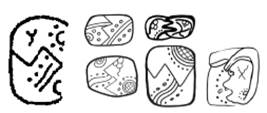![]()
![]()
![]()
K&L.p27.#4 = Zender-BH.p1.fig1.a-c TOK.p7.r4.c4 BMM9.p11.r4.c1 25EMC.pdfp30.2.1&2&3 = K&L.p27.#4.1&3&2
BAJ BAJ BAJ

KuppratApp
BAJ
· No glyphs given in K&H.
· Features:
o Can be a boulder, but usually a flint shape.
o An element resembling a “W” divides the flint or boulder into two:
§ One half has the regular internal elements of TUUN/ku/KAWAK and WITZ, namely a “pool of water” and “grapes”/“stalactite” (though the “grapes”/“stalactite” are often absent).
§ The other half has a “river band” – two parallel wavy lines, with parallel wavy elements consisting of non-touching dots, on each side of the wavy line (though this is sometimes absent from one of the sides).
· Zender-BH is the paper where this reading was formally proposed and justified in detail, now generally well-accepted. The word is most commonly encountered in the inflected form bajlaj, found, for example in the name Bajlaj Chan K’awiil, a ruler of DPL. It forms one of a set of “affective verbs” – verbs involving repetition and intensity.

![]()
K&H.p73. DP HS stair 4, step5 = Zender-BH.p2.fig2.a.1 Zender-BH.p2.fig2.c
<ba{j}:la>.ja <ba{j}:la{j}>.<[CHAN]K’AWIIL>